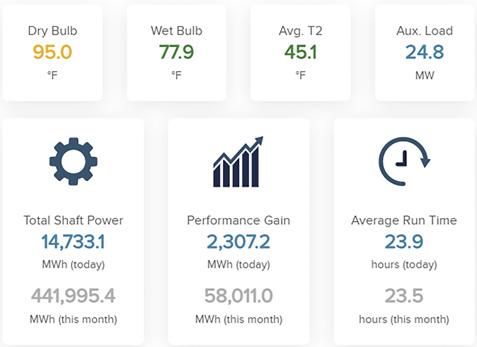
9 minute read
Keeping it cool
Steve Balek, Stellar Energy, USA, explains how digitising turbine inlet air chilling systems can help optimise maintenance activities to ensure maximum LNG production is maintained.
For liquefaction plants in warm or temperate climates, turbine inlet air chilling (TIAC) has proved to be a reliable and cost-efficient means of ensuring stable power output and, in turn, predictable LNG production. Despite this, TIAC systems are often viewed as ancillary, and thus not traditionally targeted for digitalisation to the same extent as equipment on main refrigeration trains, such as gas turbines, compressors, electrical motors, etc. However, a strong business case exists to extend performance monitoring onto mechanical TIAC systems. Doing so provides a number of benefits that directly impact a plant’s bottom line, including the ability to pre-empt failures and optimise maintenance activities so that production uptime is maximised.






Turbine inlet air chilling overview
Power output in gas turbines is proportional to inlet air density. As the temperature of ambient air rises, density decreases and so too does mass flowrate through the turbine. When dry bulb temperature exceeds the ISO-rated inlet air design point (typically 15˚C), power output begins to degrade. For LNG plants, this can potentially result in a production bottleneck, as turbine units driving main refrigerant compressor trains are unable to operate at nameplate capacity.
Numerous TIAC technologies can be employed to offset the effect of ambient air temperature fluctuations. All of these work by chilling inlet air before it enters the compressor of the gas turbine – typically to approximately 7˚C. Mechanical chilling often represents the best available technology for liquefaction plants, as it offers highly predictable performance (regardless of relative humidity) and does not require large volumes of water or complex water treatment systems. This is in stark contrast to other methods, such as evaporative cooling or fogging.
Mechanical TIAC systems operate in a similar fashion to traditional air conditioning units. A system consists of one or multiple centrifugal compressor chillers and pumps, which send chilled water (or a water-glycol solution) as a secondary refrigerant to coils downstream of a highefficiency filtration system in the gas turbine inlet filter house.
In gas turbine power generation applications, mechanical TIAC has shown to provide up to 35% output gains on hot days above 35˚C and as much as a 5% improvement in the heat rate of gas turbines. Additionally, case studies which have examined commonly applied liquefaction processes have shown that the majority of the gas turbine power gain is directly realised in LNG production gain.
The case for performance monitoring
In recent years, digitalisation has emerged as a powerful lever for helping LNG plants improve efficiency and optimise production. There are now numerous examples across the industry where facilities have used performance monitoring of critical systems to reduce downtime and associated costs through preventative maintenance.
To date, most of the focus on digitalisation in liquefaction plants has been directed at the compression train itself, and more specifically, on ensuring the uptime of major equipment assets (for example, gas turbines, compressors, electric motors, heat exchangers, etc.) Generally speaking, there has been less focus to leverage operational data from other areas, including the TIAC system.
In many cases, managers will have access to high-level information regarding their TIAC system – for example, which chillers are in operation and which are not – through the plant-wide control and monitoring human machine interface (HMI). However, they rarely have the capability to drill down into detailed performance data at the componentlevel. With little operational visibility and virtually no way to see potential issues developing, maintenance usually has to be conducted reactively after a failure occurs.
An N+1 redundancy philosophy is typically used with TIAC systems to ensure that cooling load can be met when a single chiller is taken out of service. However, in the summer months, when all chillers in the plant are operating at full capacity most (if not all) of the time, any failure or unplanned shutdown could mean a reduction in gas turbine output and corresponding drop in LNG production.
In a facility with one or more aeroderivative gas turbines, for example, on a day with ambient temperatures above 35˚C, a shutdown of multiple chillers within a TIAC plant can potentially result in up to a 20% loss in LNG production. Depending on how long it takes to determine the root cause of the failure and implement a fix, losses upwards of millions of dollars can occur.
Implementing a performance monitoring system helps mitigate this by providing plant managers with visibility into the chiller plant on a much more granular level (e.g. temperature delta across condenser coils, flowrate, efficiency, pump amperage, and so on). With the additional data, the performance of the TIAC system can be benchmarked so that any deviations which could indicate a problem can be investigated and resolved before an actual failure occurs. In this way, the existing integration gap between industrial process and business intelligence is bridged and plant managers are able to make more informed decisions with the ultimate goal of maximising LNG production.
Real-world application
Stellar Energy recently implemented a first-of-its-kind intelligent monitoring performance dashboard for a mechanical TIAC system at a large scale US liquefaction facility. The modular air-cooled system uses a non-flammable hydrofluoro-olefin as the primary refrigerant in the packaged

Figure 1. Performance curve of the gas turbines and the expected output with and without TIAC at different ambient conditions.
chillers to cool the secondary refrigerant, a low-concentration glycol solution. Using inline pumps, this solution is sent to filter house cooling coils to provide a constant 7.2˚C inlet temperature for gas turbines driving multiple compression trains. The system also uses a low concentration glycol solution sent through the condensers by inline pumps to a radiator field to remove heat from the primary refrigerant.
The TIAC performance dashboard presents easily interpreted graphs and metrics that plant managers can use to create an overall picture of the TIAC system’s impact on LNG production. Performance metrics illustrate the value of the TIAC system in terms of the current daily and current monthly performance gain (megawatt hours) and the total run time of the chiller plant (hours).
All performance calculations pertaining to gas turbine power output are calculated from a performance model curve created in power plant modelling software (Thermoflow GTPro®). The graph in Figure 1 shows the performance curve of the gas turbines and the expected output with and without TIAC at different ambient conditions. The green line indicates the real-time ambient condition. The overlaid text indicates the current change in inlet temperature and gain in megawatt output enabled by TIAC.
If a user notices that the system is not performing as expected, he or she can investigate the root cause. Key data points that can be viewed include, but are not limited to, inlet and outlet water temperatures of the turbine inlet coil and temperatures surrounding the air-cooled heat exchanger, as well as chiller plant efficiency (kilowatt per tonne of refrigeration), total auxiliary load (megawatt), total chiller load (tonne of refrigeration), and the total number of air cooled heat exchangers (ACHE) fans in operation. For each chiller, the unit diagram displays real-time chilled water and condenser cooling water temperatures and flow. In addition, it displays whether equipment is in operation or offline and the total run hours of each pump.
System reports can be generated on-demand for any selected period of time. The performance dashboard can be run locally or on a secure cloud and features an open data structure so that data is exportable to other platforms, such as enterprise resource planning (ERP) systems or other digital analytics tools.

Figure 2. Performance dashboard showing real-time performance of total chiller plant and individual chiller pairs.
Enabling preventative maintenance
With the type of detailed insight provided by the performance monitoring dashboard, plant managers can fundamentally transform the way they operate and maintain their TIAC system.
Take, for example, a damaged and/or fouled condenser coil in a chilled water loop.
Without a performance monitoring system in place, the only indication that a problem exists would likely be an increase in the inlet air temperature of the turbine and a corresponding reduction in shaft horsepower output. However, by the time the issue is noticed by personnel in the control room, the production disruption may already be underway, and the only option would be to shut down the chiller for inspection and repairs.
With a performance dashboard installed, this problem could be identified much earlier and would likely manifest in the form of a reduction in overall chiller plant efficiency (kilowatt per tonne of refrigeration). In many cases, there may be no degradation in power output, as temperature delta across the damaged condenser coil is still being maintained, but at the expense of overpumping and increased electricity consumption.
After investigating and identifying the underperforming coil, technicians can be dispatched to investigate the root cause.
The necessary spare parts can then be ordered and maintenance can be scheduled for a time when it will not impact LNG production – for example, on a day when the ambient temperature is low and the chilling load can be handled by the balance of the system. In other cases, it may be possible to perform minor maintenance to ensure that the chiller remains operational until the next scheduled plant shutdown.
Combining data insights with OEM expertise
A collaborative partnership between the original equipment manufacturer (OEM) and plant operator is often adopted when it comes to the operation and maintenance of compression train assets, such as gas turbines and compressors. TIAC systems are typically viewed as less complex. Nonetheless, the same type of approach should be employed, especially given the potential impact a failure can have on LNG production.
Implementing a TIAC performance monitoring system can provide tremendous value to LNG plants by enabling preventative maintenance and ensuring stable production. However, maximising the predictive window requires a combination of data analysis and collection, along with OEM system knowledge.
With millions of hours of accumulated operating experience, TIAC system OEMs have chilling system expertise beyond the realm of typical LNG plant personnel. This specialised knowledge is critical when determining what corrective actions to take in order to mitigate problems or optimise the system.
Facility managers can therefore benefit by engaging with an OEM before implementing a performance monitoring system. For greenfield plants, this should occur as early in the design phase as possible so that value is beginning at plant start-up.










